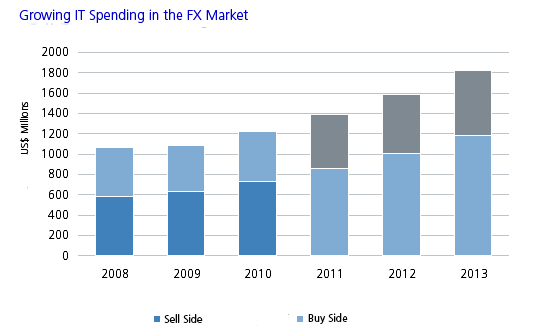Foreign exchange is the largest asset class by trading volumes. At US$4 trillion, the average daily trading volume in FX is nearly twice that of equity volumes. The high trading volumes present unique challenges in terms of operations and infrastructure.
In a new report, Technology Systems in the Global FX Market, Celent analyzes the electronification of the FX market and the growth in IT spending. Celent estimates that IT spending in FX was around US$1.2 billion in 2010. Algorithmic trading, a focus on latency and capacity building, growth of multiasset trading strategies, and enhancements in post-trade and STP will be key factors driving growth in e-FX spending over the next three years.
The success of FX is tied to higher IT spending. Competition for market share has resulted in larger banks scaling up their investments. Smaller banks have been pressed to come up with innovative approaches, and we see them moving towards providing niche offerings such as specializing in specific derivatives or currency pairs, or focus on specific segments of customers like hedge funds and asset managers.
Key findings of the study include:
In the pre-trade phase, the focus is on liquidity aggregation, enhanced analytics including complex event processing, transaction cost analysis, and better user interfaces. The increase in volume has made analytics even more sophisticated and important to the trade decision-making process. Increasing trade volumes and falling ticket size have put huge pressures on the handling of market data as well as intelligent usage of the data for valuable information.
Single-dealer platforms (SDPs) are gaining popularity, and this is mainly related to banks’ technology investments. SDPs are providing greater speed and reliability of trade execution, because they create fewer hops from execution and low-latency technology. In addition to research and analytics, SDP clients are also benefiting from superior post-trade processing capabilities and STP solutions that the banks are offering.
Unified post-trade STP solutions are in demand as trade size keeps falling and number of transactions keeps increasing. Cost reduction for the smaller players has driven demand for hosted-service models and shared services. Integration of back office in a multiprime scenario and multiasset context, while complex, is emerging as a reality and creating pressure for innovative solutions.

“In the D2C market, there is a wide spectrum of users with varied needs, and this is reflected in the solutions,” says Sreekrishna Sankar, Celent Analyst and coauthor of the report. “As the demands of the market have become increasingly sophisticated, solutions have evolved into two categories: front-to-back solutions and niche players focusing on specific aspects of the market.”
“There is heightened sensitivity to risk management across the front and middle offices. Spending on risk management solutions is rising, especially among corporations,” adds Muralidhar Dasar, Celent Analyst and coauthor of the report. “Firms are looking to gain a real time handle on portfolio topography measures, historical VaR figures, and elaborate P&L reporting.”
This report discusses trends in the global FX market and the role that technology will play in its future growth. The report analyzes the fragmented technology landscape in the market and addresses future focus areas.





